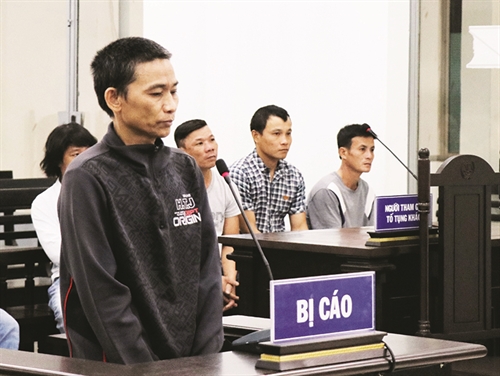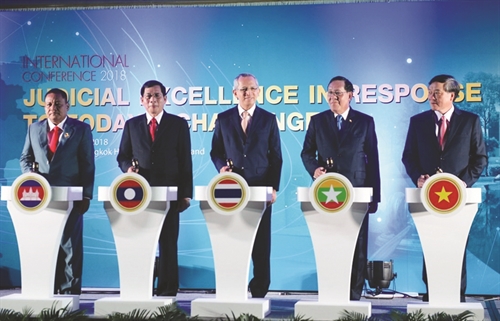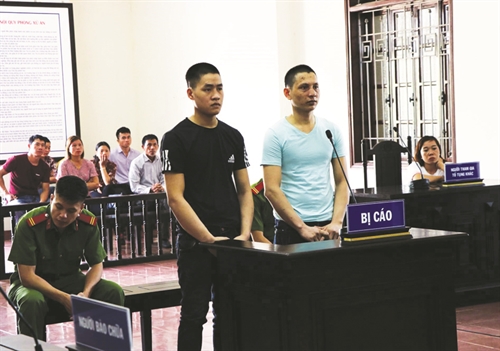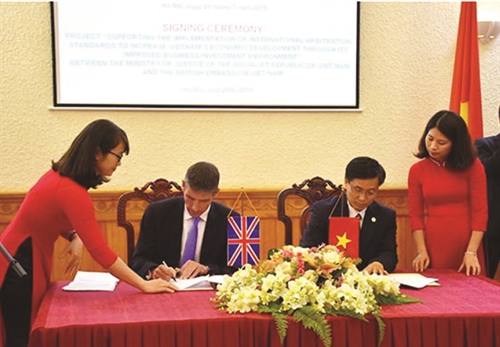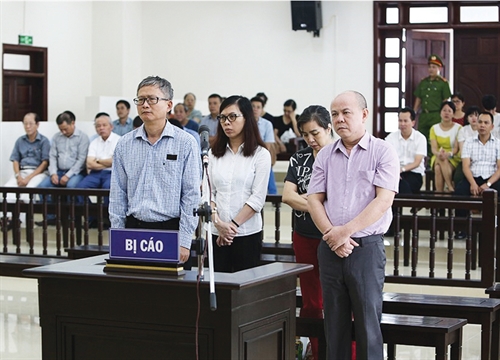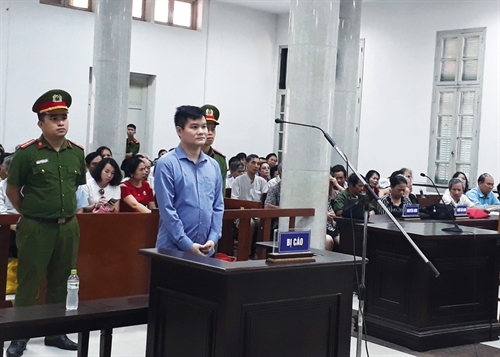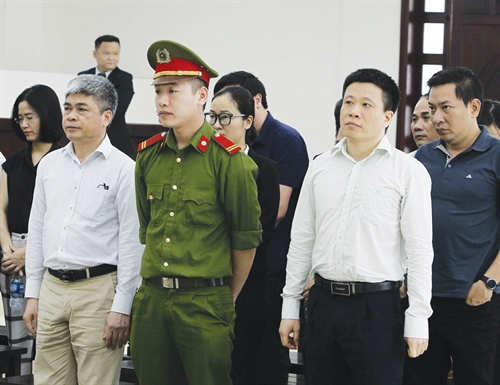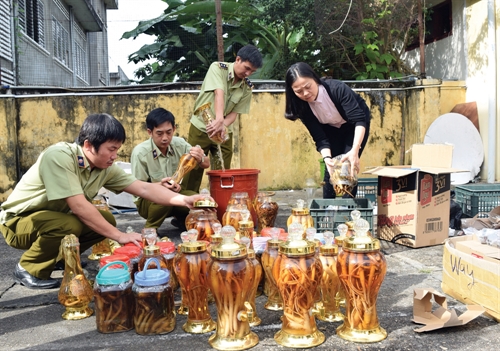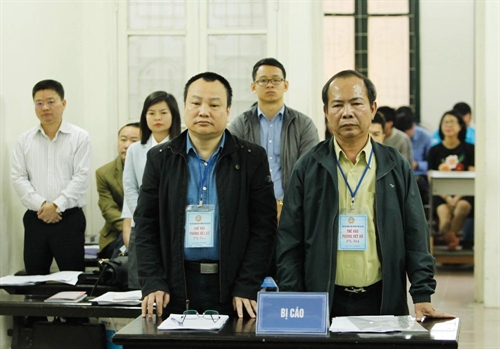State power is divided into three branches of legislative power, executive power and judicial power. Control of these powers is inevitable during the existence and development of the State. The delegation of and coordination and check among these powers help maintain transparency and unity in the exercise of state power.
Pham Hong Phong
Member of the National Assembly’s Committee on Laws
The 2013 Constitution of Vietnam provides that the state power is unified and delegated to state agencies which coordinate with and control one another in the exercise of legislative, executive and judicial powers. It also provides, for the first time, that people’s courts are judicial bodies of the Socialist Republic of Vietnam and exercise judicial power. On principle, to ensure the exercise of the state power in general and the legislative and executive powers in particular, it is necessary to build a law-ruled state with a strong judiciary system. However, since judicial power is the last one of the three powers which decides and judges the appropriateness of social relations, control of this power always requires special mechanisms and policies.
Overview of control of judicial power
Control of judicial power aims to proactively preclude, prevent and handle law-breaking acts which infringe upon judicial activities, reducing the effect and effectiveness of the state power in general and lawful rights and interests of all entities in society in particular. Judicial power is controlled by the State and society with a system of mechanisms and regulations to examine and supervise the legality and appropriateness of bodies exercising judicial power.
Based on the forms of control, the mechanisms of controlling judicial power of courts in Vietnam can be divided into two groups: the mechanism of self-control of judicial activities of courts and mechanism of control by non-judiciary institutions. In the second group, the control forms may be divided into the two sub-groups: state power-based control and non-state power-based control.
The self-control of judicial power is the mechanism whereby the Supreme People’s Court is empowered by law to control organization, operation, personnel and trial activities of courts at all levels and applies disciplinary forms in judicial activities.
State power-based control by non-judiciary institutions may be either direct control by people’s procuracies of the exercise of judicial power by courts or indirect control through supervision by people-elected bodies and other socio-political institutions.
Non-state power-based control by non-judiciary institutions is surveillance by the mass media and other non-state legal entities. This kind of control is regulated by the laws on the press, information and communications, complaints and denunciations.
From the general perspective, the control of judicial power of courts can be thought of as institutional bindings to ensure that courts operate by law-provided norms and exercise judicial power in an effective manner.
Self-control mechanism
Control of organizational structure
The current court system of Vietnam consists of the Supreme People’s Court, superior people’s courts, provincial-level and district-level people’s courts, and military courts. The Supreme People’s Court uniformly manages the organizational structure of courts nationwide, specifically as follows:
The Chief Justice of the Supreme People’s Court controls the organizational structure of superior people’s courts by issuing decisions to form judicial committees, deciding to set up and define tasks and powers of offices and other assisting units, and deciding on the appointment, relief from duty and removal from office of chief justices and deputy chief justices of these courts.
Regarding provincial-level people’s courts, the Chief Justice of the Supreme People’s Courts determines the number of members of their judicial committees, decides on the establishment and defines tasks and powers of offices, sections and equivalent units in their assisting apparatuses, and appoints, relieves from duty or removes from office their chief justices and deputy chief justices.
As for district-level people’s courts, the Chief Justice of the Supreme People’s Courts decides on the establishment and defines tasks and powers of their assisting apparatuses, and appoints, relieves from duty or removes from office their chief justices and deputy chief justices.
Control of judicial power in proceedings
In proceedings, district-level courts are assigned to conduct first-instance trials while provincial-level courts are competent to hear according to first-instance procedures cases falling beyond the jurisdiction of district-level courts and according to appellate procedures cases previously tried by district-level courts but later having their judgments appealed. They also review legally effective judgments and rulings of district-level courts and propose chief justices of superior people’s courts or the Chief Justice of the Supreme People’s Court to consider making protests upon detecting violations or discovering new circumstances. Superior people’s courts control the operation of provincial-level and district-level people’s courts by conducting appellate trials for cases previously settled by provincial-level people’s courts according to first-instance procedures and reviewing according to the cassation or reopening procedures legally effective judgments and rulings rendered by provincial-level and district-level people’s courts.
Control by administrative measures
People’s courts control the operation of their own system by issuing internal regulations and rules to regulate activities of their officers and employees. For example, the Chief Justice of the Supreme People’s Court issued on June 19, 2017 Decision 120/QD-TANDTC on the Regulation on handling of judicial title holders in people’s courts. This decision serves as a basis for the application of principles, forms, competence, order, procedures and time limit for examination of responsibility of judicial title holders in people’s courts who commit violations due to irresponsibility or during their task performance which are not serious enough for being disciplined. Another example is Decision 87/QD-HDTC dated July 4, 2018, of the National Judge Selection and Supervision Council, issuing the Code of Judicial Conduct which is intended for building a standard pool of judges who are independent, impartial, fair and diligent and abide by the law only while performing their duties.
Control by non-judiciary institutions
State power-based direct control
Regarding its organizational structure, the court system submits to direct control by the National Assembly. The National Assembly promulgates the Law on Organization of People’s Courts to provide for functions, tasks, powers and organizational structure of courts; approves the organizational apparatus, tasks and powers of units in the assisting apparatus of the Supreme People’s Court; elects, relieves from duty or removes from office the Chief Justice of the Supreme People’s Court at the request of the President; and approves proposals on the appointment, relief from duty or removal from office of the Chief Justice of the Supreme People’s Court.
The National Assembly also decides on operation budgets of courts other than limitary courts.
The National Assembly Standing Committee decides to establish or dissolve district-level courts, provincial-level courts, superior people’s courts and military courts, and establishes specialized tribunals at the request of the Chief Justice of the Supreme People’s Court; decides on the number of senior, secondary and primary judges and proportions of judge ranks at each court level; decides on the list of members and working regulation of the National Judge Selection and Supervision Council; and provides for salaries and allowances of judges, assessors, examiners and court clerks.
In proceedings, courts submit to the control (supervision) of judicial activities by people’s procuracies. Supervision of judicial activities aims to supervise the legality of acts and decisions of agencies, organizations and individuals in judicial activities in the course of settlement of criminal or administrative cases, civil disputes or matters, marriage and family affairs, trade or labor disputes, or in the execution of judgments or the settlement of complaints or denunciations in judicial activities in accordance with law.
The supervision by people’s procuracies of judicial activities of courts aims to ensure that the aforesaid settlement and other judicial activities are carried out lawfully and that all violations in judicial activities are detected and promptly and strictly handled.
To supervise judicial activities of courts, people’s procuracies are empowered to request all entities to carry out judicial activities in a lawful manner and self-inspect their activities and report inspection results to people’s procuracies.
These entities must provide files and documents to people’s procuracies for supervising legality of acts and decisions in judicial activities.
People’s procuracies can verify and collect documents to identify and handle violations in judicial activities; request competent agencies, organizations and persons to remedy and strictly handle violations in judicial activities; propose concerned agencies and organizations to take measures to prevent violations and crimes,
They can also file protests against unlawful court judgments and rulings as well as unlawful acts and decisions of other competent agencies and persons in judicial activities.
They have the task of supervising the settlement of complaints and denunciations in judicial activities and can directly settle complaints and denunciations falling under their competence.
Non-state power-based control
Non-state power-based control is effected through investigation and reporting by the mass media, filing of complaints and denunciations by citizens, agencies and organizations about operation of people’s courts and activities of cadres and civil servants in the court system.
In order to increase the effectiveness of indirect control of judicial power, the Supreme People’s Court has launched its e-portal to receive petitions as well as publicize legally effective court judgments and rulings for public opinion.
Some recommendations
That the 2013 Constitution states that the state power is unified and delegated to state agencies which coordinate with and control one another in the exercise of legislative, executive and judicial powers has necessitated the control by executive bodies of the judiciary. However, at present the Government may only indirectly control the operation of courts through giving its opinions on their state payrolls and operation funding. In fact, these matters are subject to decisions of the legislature. Meanwhile, the exercise of judicial power by courts (adjudicating activities) is subject to direct control by procuracies that are non-executive.
In order to meet the Constitution’s requirement on enhancing the power check among the legislative, executive and judiciary systems, authority should be vested in the Government to directly control judicial activities of courts. In other words, bodies supervising judicial activities should belong to the executive system.
Self-control of judicial power by courts is also quite necessary to prevent abuse of judicial power and, therefore, should be enhanced. In order to ensure an effective and efficient self-control mechanism, management powers and responsibilities should be reasonably delegated to all court levels and human resources of the court system should be strongly developed. In addition to the regulations on control of organizational structure and proceedings, there should be mechanisms for training high-quality judicial title holders of courts and offer adequate salaries to judicial officers.
As adjudicating activities constitute the most important part of judicial power and judges must be knowledgeable about laws, human physico-psychology, culture, economics, politics, etc., judges should be selected among not only judicial civil servants but also other judicial title holders who are capable.-
